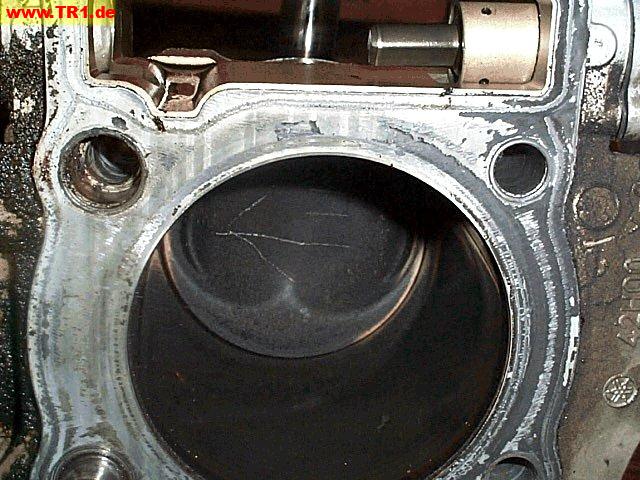Let’s remove the heads and cylinders.
The left side cover has been removed, exposing the flywheel, alternator rotor, and the left-side crankshaft nut. The starter gears tend to fall out when the side cover is removed; they’re on the shop rag, below the oil drain plug.
The alternator stator remains bolted to the sidecover.
In hindsight, it’s cleaner to initially remove only the bezel and crankshaft cover from the left sidecover. We can use a socket instead of a wrench to rotate the crankshaft when repositioning the camshafts.
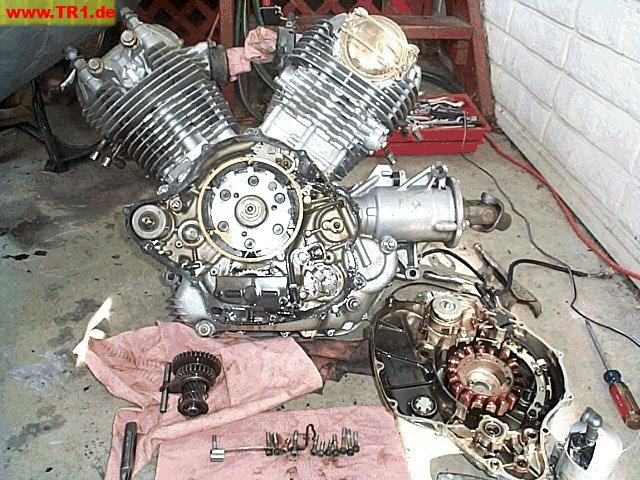
Left side.
The rear camshaft gear is at 1 o’clock.
The clutch pushrod is at 3 o’clock.
Shifter shaft and drum are at 5 o’clock.
Oil pump (with chain cover) at 6 o’clock.
Starter one-way clutch at 9 o’clock.
The round hole between the starter clutch and alternator is for the starter gear shaft.

Here’s a picture of the starter gear assembly from earlier this month.
Bottom row, left-to-right: idler gear 1, idler gear 2, and idler wheel with spring.
Top row, left to right: starter shifter fork (Yamaha calls this a drive lever shaft), magnet in square plastic carrier, and starter wheel shaft with o-ring.
The right end of the shifter fork is attached to the solenoid lever by a collar and one of the only two torx screw on the whole bike(!), if I recall correctly.
When the solenoid is actuated, the fork and its gear#2 are pulled to the right, into the alternator ring gear. Around this time, the solenoid energizes power to the starter motor.
The starter motor turns the starter clutch which is geared to gear#1, which is splined to the idler wheel, which is splined to gear#2. The magnet catches the metal shavings. Yes, really.
The starter clutch and gear#2 have both been replaced at least once. On separate occasions. A web search suggests that Yamaha has redesigned gear#2, the idler wheel,
and eliminated the spring, possibly so that gear#2 turns less as it hurtles towards the alternator gear.
The Virago 700’s have a somewhat different starter arrangement with somewhat different failure modes.
The flattened PC power supply case (visible in the upper-right corner of this image) is a sidestand rest, and is not otherwise associated with Virago starter repairs.

Left side cover.
The starter solenoid (at 2 o’clock, over the screwdriver handle) remains attached to the side cover.
Ignition pickup coils are at 11 and 2 o’clock, above the alternator stator coils.
The oil check sight glass at 5 o’clock. The recommended level is between the bottom and top of the glass. No dipstick on this model.
The shifter shaft hole is at 7 o’clock.
The clutch worm drive is at 9 o’clock. When the clutch handle is squeezed, the worm drive pushes the clutch pushrod.
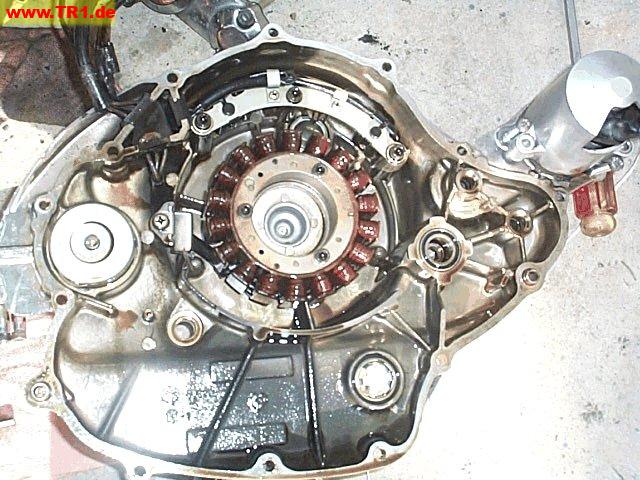
Left side cover hex bolts and the clutch cable clamp.
The red instant gasket had previously been used to eliminate a possible source of oil seepage under the clutch adjuster cover.

Here’s an earlier image showing a new clutch adjuster seal in place, just prior to reinstallation of the clutch adjuster arm, spring and cover. Oil seepage was finally traced to the clutch adjuster shaft seal, and the seal was replaced – but not before one of the hex bolts was slathered with red instant gasket.
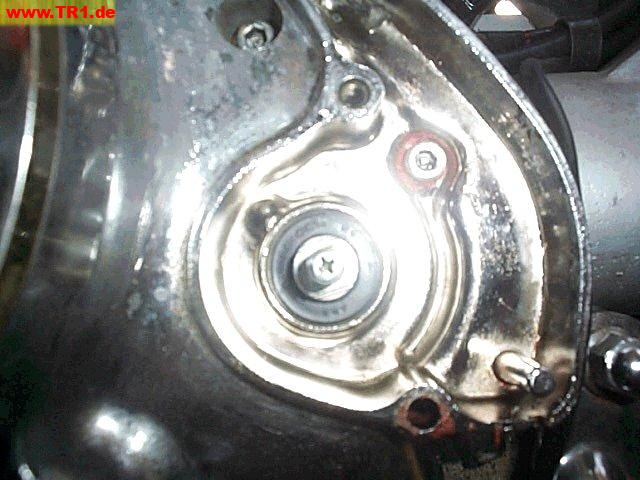
Access to the transmission requires separation of the case halves. As this Yamaha crankcase splits into left/right halves, the cylinders and heads must first be removed. Contrast this with the Honda case halves that I’m familiar with: just flip the engine upside-down and remove the bottom case half to work on the transmission. On a smaller engine, it’s not even necessary to remove the engine from the frame. :-)
We’ll start with the rear cylinder.
The rear cylinder cam chain cover has been removed; it’s perched below the rear cam chain tensioner (at 2 o’clock).
To relieve chain tension on this camshaft, the crankshaft is rotated until both valves in this head are closed.
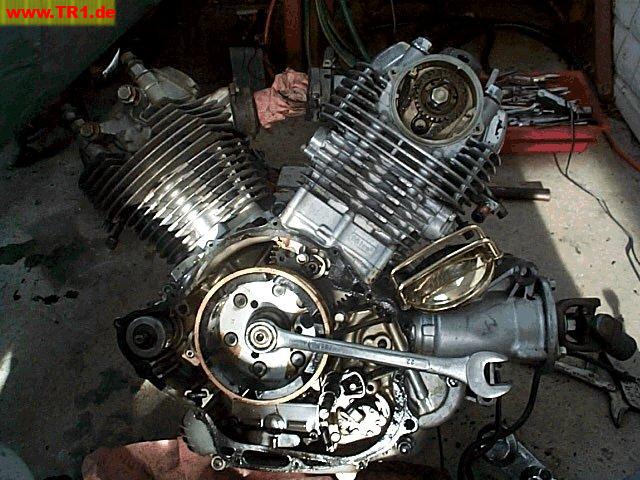
The cam chain sprocket index dot is a half-tooth from straight up, so the cam chain is no longer under tension from the camshaft valve springs. After the cam chain tensioner is removed, the cam chain should be loose.
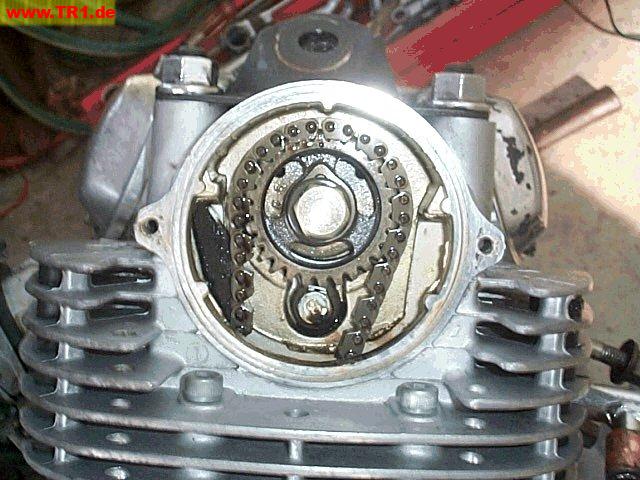
The camshaft chain tensioner (under the exhaust port at the right) has been removed.
We’ve also temporarily removed and replaced the camshaft sprocket to unthread the chain.
Later, we’ll prevent the rear chain from jamming around its lower sprocket (when we rotate the front camshaft) by pulling this chain up by its rubber band.
The camshaft is not under tension: the index mark has freely moved to its 2 o’clock position.
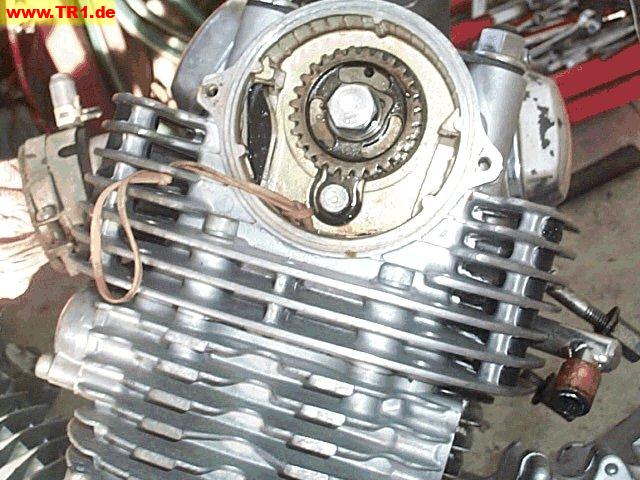
The 4 large nuts and 3 hex bolts holding the head to the cylinder have been removed, and the head has been pulled off with a little bit of wiggling. This is a view of the underside of the head: the exhaust studs are now to the left; the spark plug hole is between the valves.
One of the cam chain guides protrudes from the cam chain hole.
Aside from a bit more carbonized deposits (which we’ll clean off – later), conditions look nominal to me. The exhaust valve is a nice tan colour: exhaust gasses are hot.
Generally, intake valves are larger than exhaust valves — it’s harder to suck than it is to push.
The two dowels near the exhaust fit into matching holes in the cylinder.
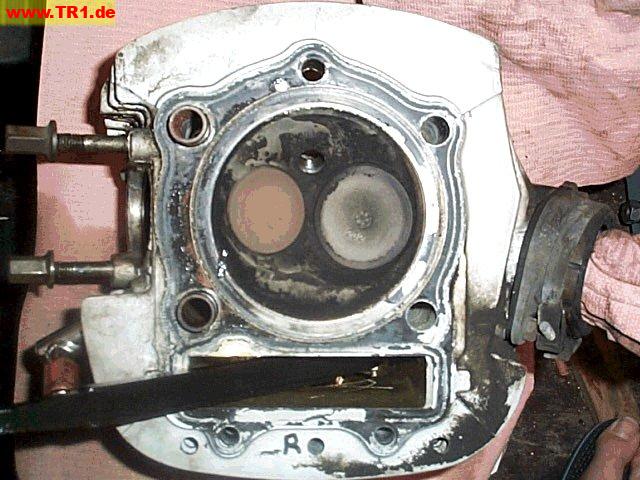
Rear head valves.

Looking into an intake port. The valve guide, and a bit of the valve stem, is visible. The rubber carb fitting is reasonably pliable.
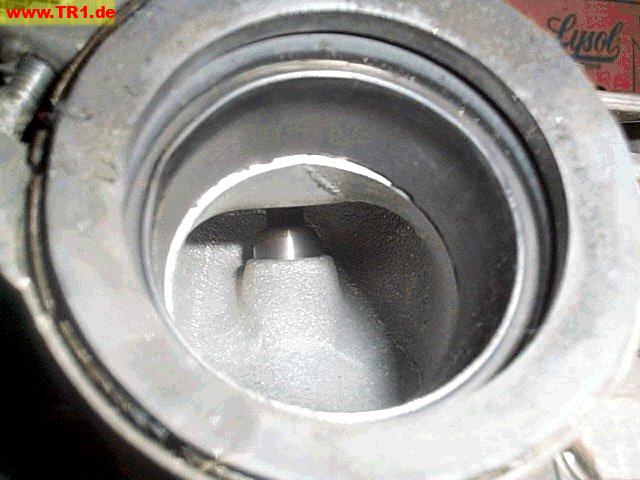
Looking into an exhaust port. The valve guide and stem are visible.
We’ll remove most of these deposits – later.
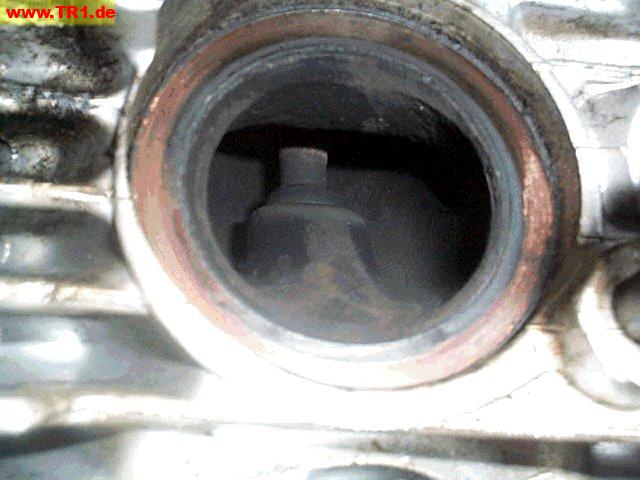
The top of the rear cylinder, with the piston.
The arrow points to the front. We’ll carefully clean the carbon off – later.
The rear cam chain tensioner is visible.
A dowel is nearby.
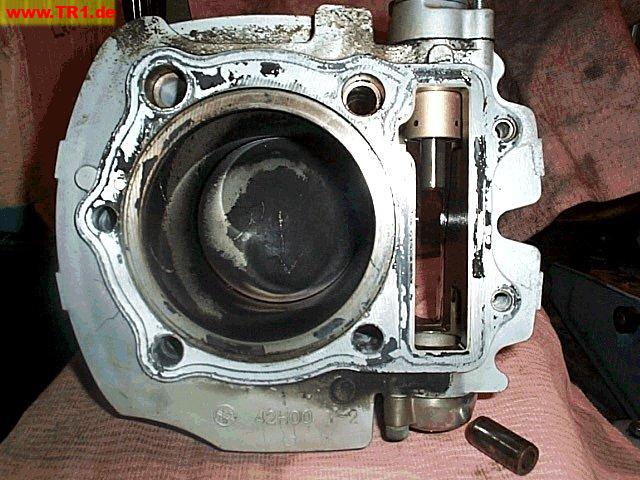
The bottom of the cylinder, piston, and wrist pin.
The wrist pin has been tapped out just far enough to free it from the rod.
The few small holes around the sides of the piston appear open; they’re for oil distribution.
The orange ring is a high-temperature oil seal.
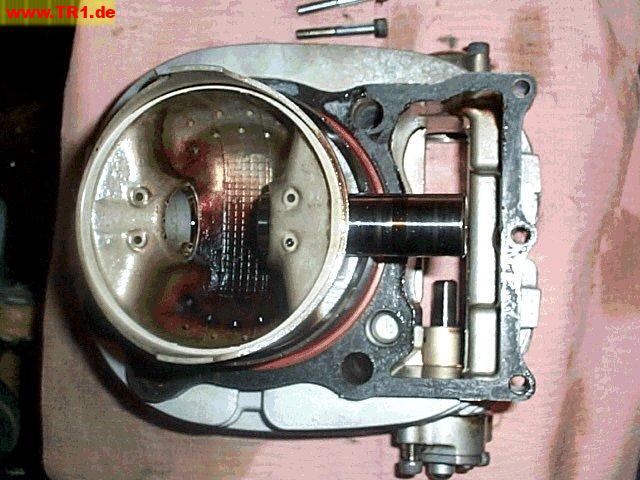
The rear head and the cylinder/piston/wrist pin assembly have been removed. The rear cylinder head studs, rod, cam chain, and cam chain rear guide are visible.
While the piston was being disconnected from the rod, the wrist pin clip flew off somewhere – commonly considered humorous.. when it happens to someone else. It becomes the stuff of legend if it occurs during reassembly. ;-)
We’ll check the crankcase for this part later.
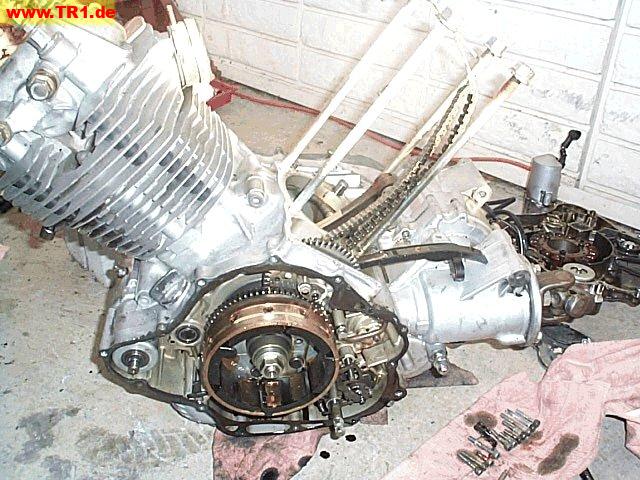
This is a good view of the rear cam chain, sprocket, gear, and rear chain guide. (The front chain guide remains attached to its cylinder.)
The front of engine is to the left.
The cam chain gear is really two gears back-to-back, spring-loaded to remove valve lash (sloppiness).
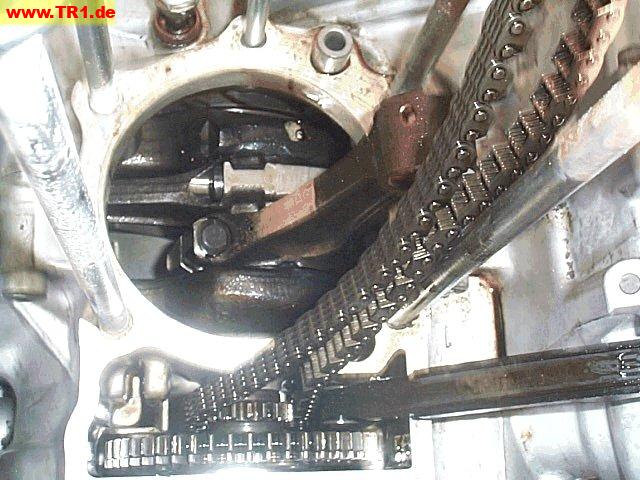
Front cylinder removal. The cam chain has been unthreaded from the camshaft sprocket and the cam chain tensioner has been removed. This cam sprocket has an oil slinger because this cam chain cover also has a breather tube attached to it. The front head is ready to be unbolted.
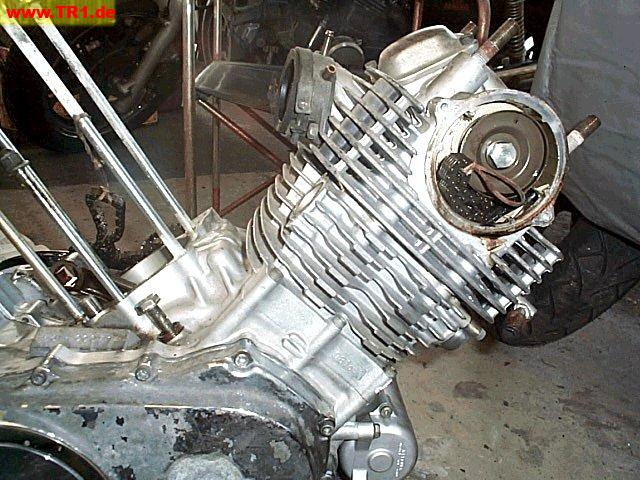
Front head being removed. The 4 head nuts and 3 head bolts have already been removed. Gentle prying between the fins (not at a mating surface) was used to start the separation.

Underside of the front head.
The exhaust studs, anti-smog tube and exhaust valve are on the left.
The intake clamp and intake valve are to the right.
The spark plug thread is in the middle of the cylinder.
The cam chain sprocket is visible.
This head has more combustion chamber deposits than the rear.
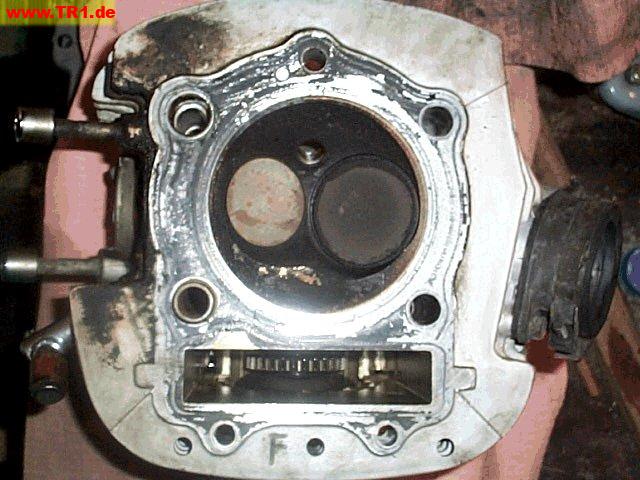
A close-up of the front head. Deposits are visible, but will clean up. The cam chain sprocket is at the bottom.
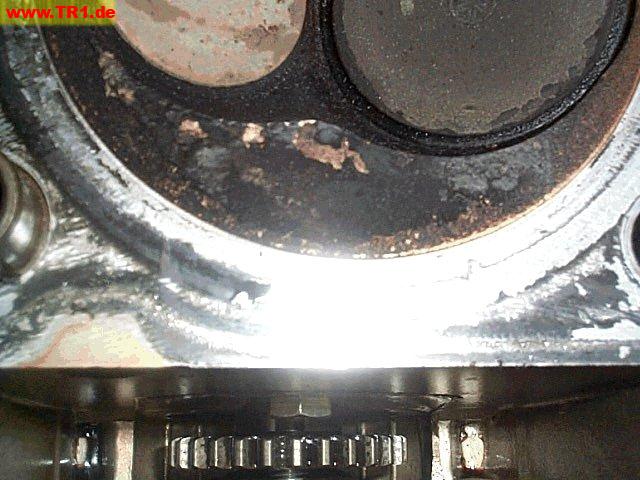
The front cylinder/piston assembly has been raised far enough to disconnect the piston wrist pin from the connecting rod, but not far enough to release the rings from the cylinder. The front piston and connecting rod are visible.

The wrist pin fastens the piston to the connecting rod. The wrist pin clip from this piston was treated with the respect properly bestowed to a springy object over a dark and twisty passage.
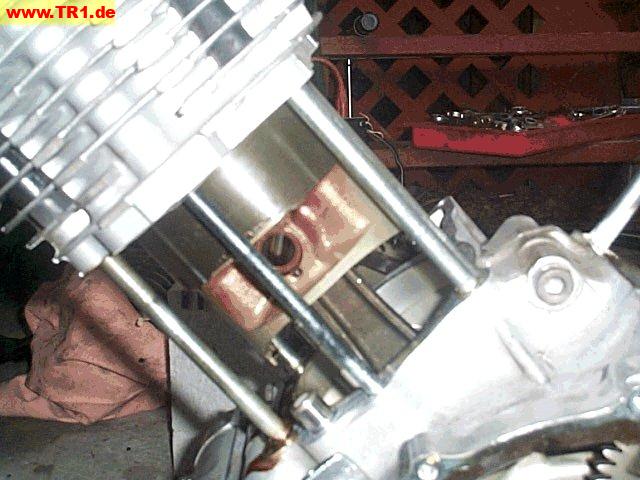
Front cylinder. Arrow points front.
